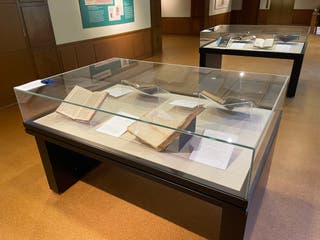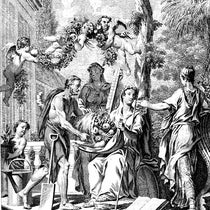History of Science on Display - JUNE 2022: LGBTQIA Histories in Science
In celebration of Pride Month, we have gathered together eight examples of noteworthy scientists who lived queer and trans lives from the 16th century to the 21st.
Our definitions of heterosexuality and homosexuality are relatively recent inventions. Some of the scientists represented here would not have defined themselves as LGBTQIA, and many even had conventional marriages. Before the late 20th century, most queer people found ways to keep their personal lives hidden, guarding themselves against social and legal retribution. To be what we would now call publicly out was extremely rare. In many cases, it is only through scandal, like Georg Joachim Rheticus’ banishment from Leipzig, that the historical record preserves the traces of queer and trans stories. In others, we learn about a figure’s personal life only after death, like in the discovery of the letters between Rachel Carson and Dorothy Freeman. Though our modern understanding of sexuality comes from the 19th century, people have lived queer lives for as long as there have been people.
In the spirit of honoring the history of science as well as the history of gender and sexuality, this exhibition looks at these scientists not just in terms of their scientific legacies, but of the richness and complexity of their personal lives.
June's featured scientists:
Georg Joachim Rheticus (1514-1576)
Thesaurus Mathematicus
Frankfurt, 1613

Georg Joachim Rheticus, ed. Bartholamaeus Pitiscus & Valentinus Otho, Thesaurus Mathematicus. Frankfurt, 1613.
Georg Joachim Rheticus, best known for shepherding Nicolas Copernicus' De Revolutionibus into print, was a key figure in early modern mathematics and astronomy. The book on display here is the culmination of his life’s work on trigonometry, edited and completed by two generations of Rheticus’ disciples – Valentin Otto and Bartholomew Pitiscus.
Rheticus' brilliant academic career came to an untimely end in 1551, when a local merchant charged him with seducing his son, a student of Rheticus’ at the University of Leipzig. Rather than face the very real possibility of capital punishment, Rheticus fled to Prague. The university court prosecuted the case in his absence, eventually sentencing Rheticus to 101 years in exile. By 1554, he had settled in Krakow and began practicing medicine. Though he would continue his mathematical work independently, he never held another university position.
Francis Bacon (1561-1626)
Nevv Atlantis. A vvorke unfinished
London, 1628

Francis Bacon, Nevv Atlantis. A vvorke unfinished. London, 1628.
Francis Bacon is celebrated as the "father of modern science" for developing what we now call the scientific method. Bacon was also a moral and political philosopher, as well as a favorite of King James I, who appointed him Lord High Chancellor. The work on display is his New Atlantis, an account of a utopian society. Here, Bacon uses the uncommon phrase "masculine love" to describe same-sex attraction, rather than a pejorative term like sodomy. Of course, when we read the text we realize that Bacon would have been excluded from his own utopia.
Historians before the 1990s tended to dismiss evidence of his physical and romantic relationships with men. However, more recent research re-examines his personal life, as well as his published work. This re-appraisal includes New Atlantis, as well as essays like "Of Beauty," in which only men are examples, "Of marriage and a single life," which describes a wife and children as "impediments to great enterprise," and "Of Friendship," inspired by his lover Sir Tobie Matthew.
Alan Turing (1912-1954)
“On Computable Numbers, with an Application to the Entscheidungsproblem.”
Proceedings of the London Mathematical Society
London, 1936

Alan Turing, “On Computable Numbers, with an Application to the Entscheidungsproblem.” Proceedings of the London Mathematical Society. London, 1936.
Alan Turing was one of the single most influential figures in the development of computing. In this article, he presents his groundbreaking “universal machine,” a general-purpose, programmable computer.
In 1952, Turing was arrested and convicted for having a sexual relationship with another man, a criminal act under the British legal system. When offered the choice between chemical castration and imprisonment, Turing chose to avoid prison in order to keep his access to a computer. In a letter to fellow mathematician Norman Routledge after his conviction, he closed on a bittersweet note:
"No doubt I shall emerge from it all a different man, but quite who I’ve not found out.”
He died two years later from cyanide poisoning. Investigators ruled his death a suicide, though some historians contend it may have been accidental.
Frank Kameny (1925-2011)
“Photoelectric colors of RV Tauri and yellow semiregular variables.”
Astronomical Journal
New Haven, 1957

Frank Kameny, “Photoelectric colors of RV Tauri and yellow semiregular variables.” Astronomical Journal. New Haven, 1957.
In the mid 1950s, Frank Kameny was a promising astronomer who hoped to become an astronaut. This conference paper abstract stems from his doctoral research, done under the supervision of Cecilia Payne-Gaposchkin. It was published in the same year that his astronomical career came to an untimely end.
Kameny was a victim of the Lavender Scare, a period of intense discrimination against LGBTQIA people in federally-funded jobs, connected with McCarthyism. Having unsuccessfully disputed his firing from the Army Map Service at the Supreme Court, Kameny founded the militant gay rights organization the Mattachine Society in 1961. He organized some of the first gay rights protests in the country, picketing the White House in 1965, and successfully campaigned to have homosexuality removed from the American Psychiatric Association's list of mental disorders.
Rachel Carson (1907-1964)
Silent Spring
Cambridge MA, 1962
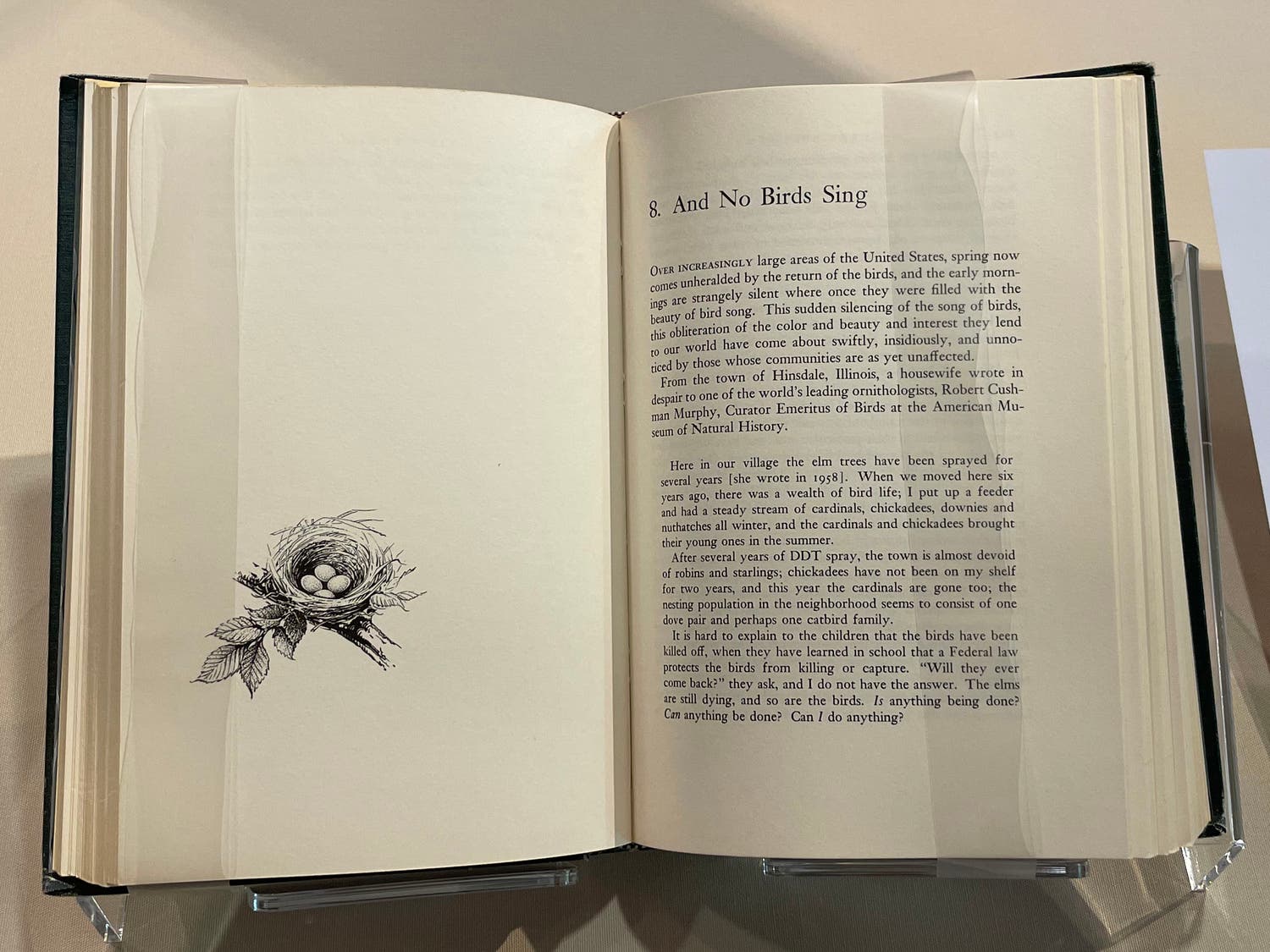
Rachel Carson, Silent Spring. Cambridge MA, 1962.
Rachel Carson's Silent Spring launched the environmental movement. In it, she describes the devastating effects of pesticides on ecosystems, combining thorough scientific research with the persuasive prose that had already made her a bestselling author.
Carson wrote and researched Silent Spring after she moved to Southport Island, Maine to care for her aging mother. It was in this same town that she met Dorothy Freeman, who would become the great love of her life. In her letters, she credits Freeman as her most important source of inspiration and emotional support. Prior to Carson's death, both women deliberately destroyed select portions of their personal correspondence, leaving behind a body of letters that suggest the emotional intensity of their relationship while leaving its physical aspects ambiguous. Her final surviving letter to Freeman ends with this haunting line:
“Never forget, dear one, how deeply I have loved you all these years”
Sally Ride (1951-2012)
To Space & Back
New York, 1986
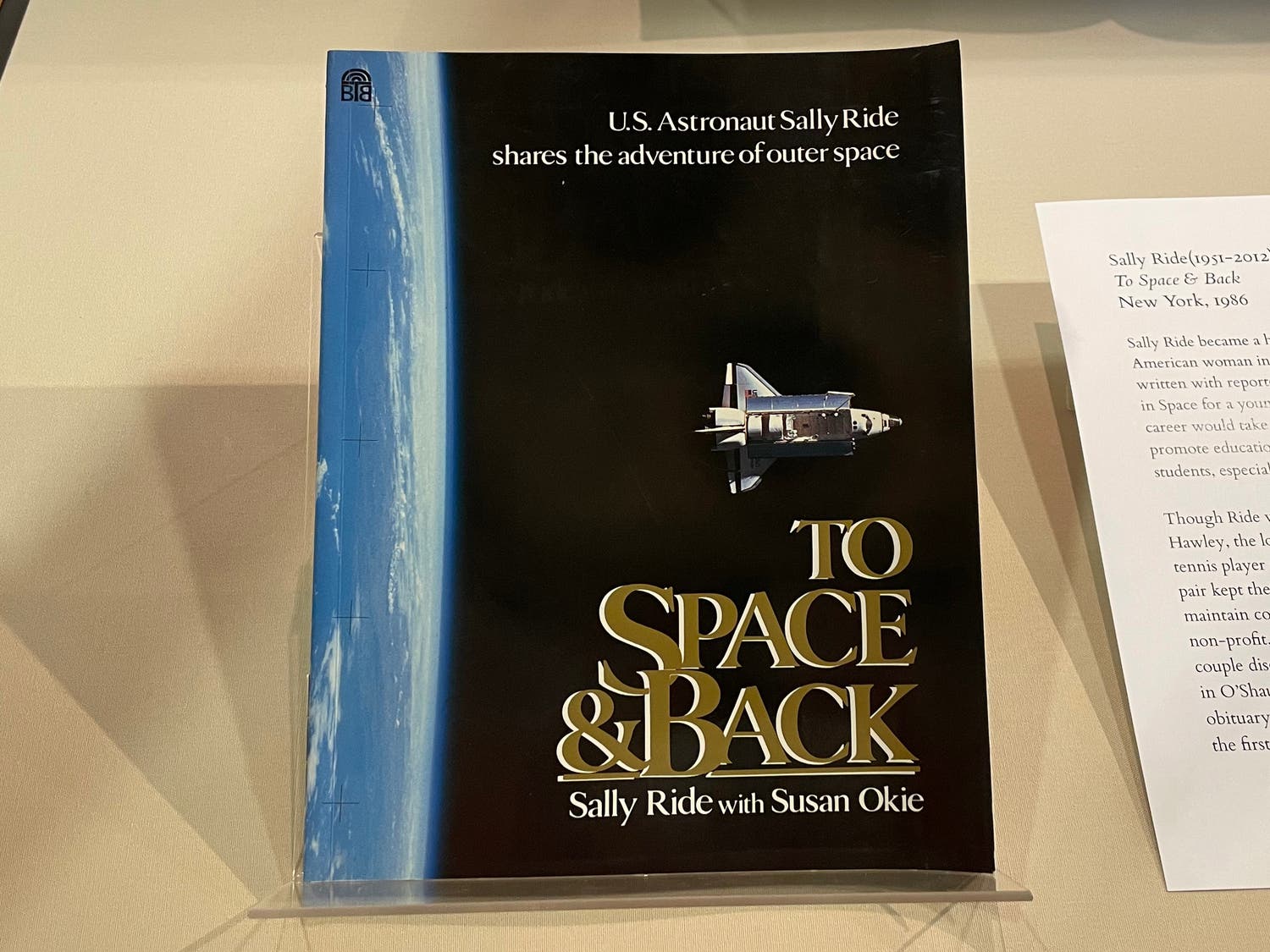
Sally Ride & Susan Okie, To Space & Back. New York, 1986.
Sally Ride became a household name in 1983 as the first American woman in space. This popular science book, co-written with reporter Susan Okie, describes Ride's experience in Space for a young audience. It reflects the direction her career would take in later years, as she campaigned to promote education in science and mathematics for K-12 students, especially young women.
Though Ride was briefly married to fellow astronaut Steve Hawley, the longest relationship of her life was with the tennis player and science writer Tam O'Shaughnessy. The pair kept their personal lives largely private, in part to maintain corporate sponsorships for their STEM education non-profit, Sally Ride Science. At the end of Ride's life, the couple discussed coming out, with Ride leaving the decision in O’Shaughnessy’s hands. O'Shaughnessy then wrote Ride's obituary, stating the nature of their relationship in public for the first time in 27 years.
Edith Windsor (1929-2017)
“Pioneer day”
AFIPS conference proceedings v. 56
Chicago, 1987
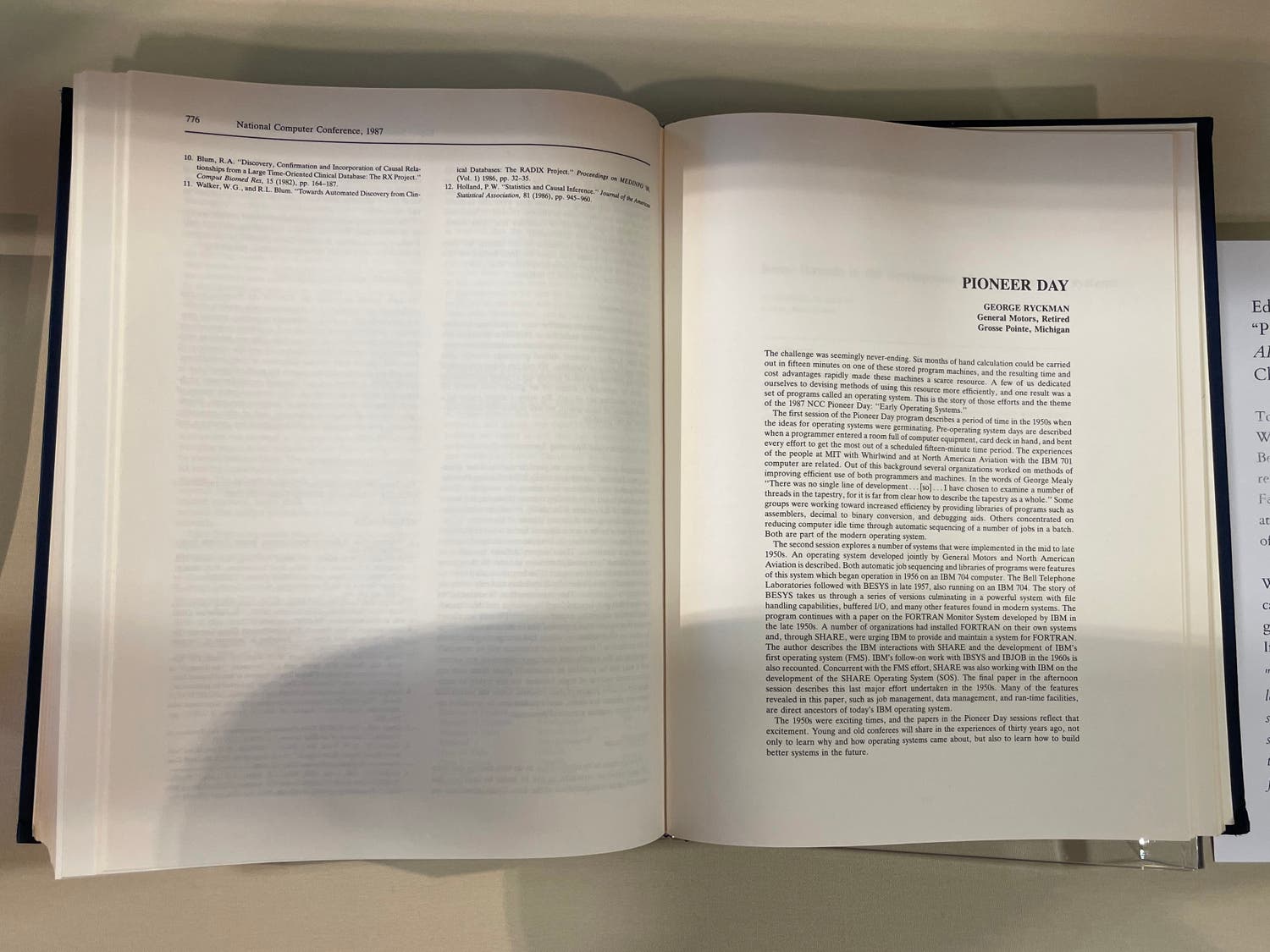
George Ryckman, “Pioneer day,” AFIPS conference proceedings v. 56. Chicago, 1987.
Today, Edith Windsor is best known for the United States vs Windsor, which struck down the Defense of Marriage Act. Before she became an LGBT rights activist, she was a well-respected software engineer at IBM. In 1987, the American Federation of Information Processing Societies honored her at their annual conference, along with other early “pioneers” of open-source software.
Windsor attended the AFIPS conferences throughout her career, and it was at one of these conferences, in an informal gathering of friends, that she first came out to her colleagues. In an interview given in 2015, she described this moment:
"I would learn about their wives; I would learn whose kids were no longer on three-wheelers, they were on two-wheelers; and I never said a word. And then I met Thea, and I finally said 'Guys, I'm sitting here and I'm not saying anything and the most important thing in my life has happened.' And I told them. So they knew fifteen years before anybody at IBM knew."
Ben Barres (1954-2017)
“Does Gender Matter”
Nature
London, 2006

Ben Barres, “Does Gender Matter,” Nature. London, 2006.
Ben Barres was a neurobiologist who studied the effects of glial cells in the brain on development and disease. His career as an activist began with the landmark article on display here, a reaction to Larry Summers' infamous 2005 public statement about women's "innate inability" in the sciences. In it, he marshals his own experiences pre-transition, as well as a substantial body of scientific evidence.
Barres began his transition in 1997 at age 43, after having gained tenure at Stanford. Barres realized that he was transgender thanks to a pivotal article in the San Francisco Chronicle about trans activist Jamison Green. Barres describes in his autobiography how Green's story was the first time he had heard the word transgender, and the first time he heard a personal story that mirrored his own. Post-transition, Barres dedicated his life to advocacy and mentorship, while continuing his groundbreaking research.
The Linda Hall Library holds one of the best collections of rare printed science, technology, and engineering works in the world. Each month, our History of Science experts will curate a special collection of rare books for Library visitors to enjoy. This month’s display, LGBTQIA Histories in Science, will be on display in the Library’s West Exhibit Hall through June 2022.
The Library is open to the public free of charge during regular Library hours, Monday – Friday, 10:00 a.m. – 5:00 p.m.

